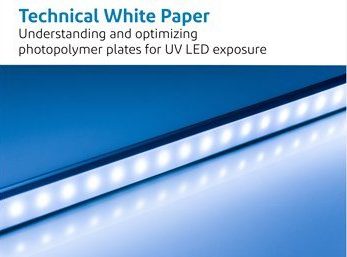
DuPont’s new Cyrel Lightning photopolymer plate is optimized for LED UV exposure and can save up to 42% higher productivity in the flexographic platemaking process. LED lamps are increasingly used for curing inks in printing and for the UV exposure of flexographic plates instead of the conventional florescent tube systems known as ‘bank exposure.’ While LED exposure can bring many benefits to the flexographic platemaking, for non-optimized photopolymers, using this unique exposure process can require compromises in productivity and quality. However, the new Cyrel Lightning made for LED UV exposure plates deliver higher productivity, improved plate quality and superior print quality.
While one can achieve very short exposure times using the maximum UV output (since LED emit UV radiation at a very high intensity that is 15 to 20 times higher than florescent banks and have a narrower emission spectrum), tradeoffs in quality may occur especially when using flexo photopolymer plates that have been designed for the bank exposure.
DuPont’s technical white paper on ‘Understanding and optimizing photopolymer plates for UV LED exposure’ says, “Often, the combination of high output and short exposure time leads to larger minimum dots, pronounced shoulders of printing elements and cupping, which all can contribute to less latitude on press and lower print quality. This challenge often requires LED exposure times to be longer in order to prevent the quality issues mentioned above.”
The challenge in flexo terms is to achieve a crisp surface, but also a sufficient curing of the center of the photopolymer material in, forming fine elements and surface structures while photopolymerizing the bulk of the material sufficiently for stable shoulders and acceptable through-cure.

The Solution
If photopolymer formulations were optimized for LED exposure from the start, there would be less of a need to compromise between productivity and quality. Optimized flexo plates along with experienced application support staff yield the best results. With chemistry, the photopolymer plate can be redesigned for LED exposure.
DuPont has rethought plate formulation, specifically for UV LED exposure for the new Cyrel Lightning series of photopolymers plates. The plate series uses chemistries with tailored UV profile to achieve a balance between surface and through cures. The innovation enables fast surface cure that effectively mitigates oxygen inhibition between passes of LED exposure when the plate is in the dark. At the same time, it provides sufficient through-cure through a finely tuned UV absorption profile.
This leads to an exposure time reduction of up to 42% in the respective platemaking processes and improved quality especially in isolated highlight dots and superior print quality amongst LED-exposed plates.









